2007 MITSUBISHI LANCER EVOLUTION battery
[x] Cancel search: batteryPage 1375 of 1449
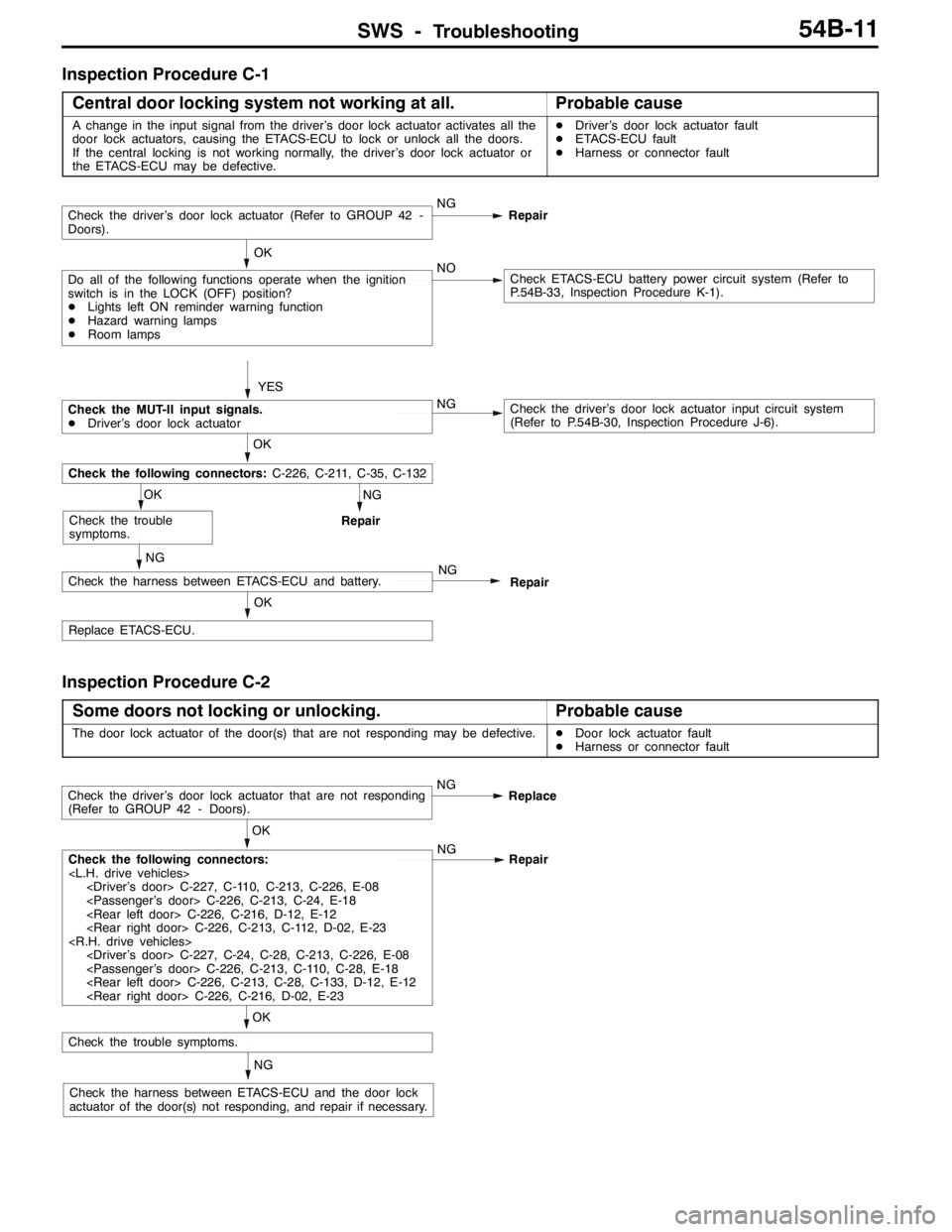
SWS -Troubleshooting54B-11
Inspection Procedure C-1
Central door locking system not working at all.
Probable cause
A change in the input signal from the driver’s door lock actuator activates all the
door lock actuators, causing the ETACS-ECU to lock or unlock all the doors.
If the central locking is not working normally, the driver’s door lock actuator or
the ETACS-ECU may be defective.DDriver’s door lock actuator fault
DETACS-ECU fault
DHarness or connector fault
NG
Repair
OK
Replace ETACS-ECU.
NG
Check the harness between ETACS-ECU and battery.NG
Repair
OK
Check the trouble
symptoms.
OK
Check the following connectors:C-226, C-211, C-35, C-132
YES
Check the driver’s door lock actuator (Refer to GROUP 42 -
Doors).NG
Repair
Do all of the following functions operate when the ignition
switch is in the LOCK (OFF) position?
DLights left ON reminder warning function
DHazard warning lamps
DRoom lampsNOCheck ETACS-ECU battery power circuit system (Refer to
P.54B-33, Inspection Procedure K-1). OK
Check the MUT-II input signals.
DDriver’s door lock actuatorNGCheck the driver’s door lock actuator input circuit system
(Refer to P.54B-30, Inspection Procedure J-6).
Inspection Procedure C-2
Some doors not locking or unlocking.
Probable cause
The door lock actuator of the door(s) that are not responding may be defective.DDoor lock actuator fault
DHarness or connector fault
NG
Check the harness between ETACS-ECU and the door lock
actuator of the door(s) not responding, and repair if necessary.
OK
Check the trouble symptoms.
OK
Check the following connectors:
Repair
Check the driver’s door lock actuator that are not responding
(Refer to GROUP 42 - Doors).NG
Replace
Page 1379 of 1449
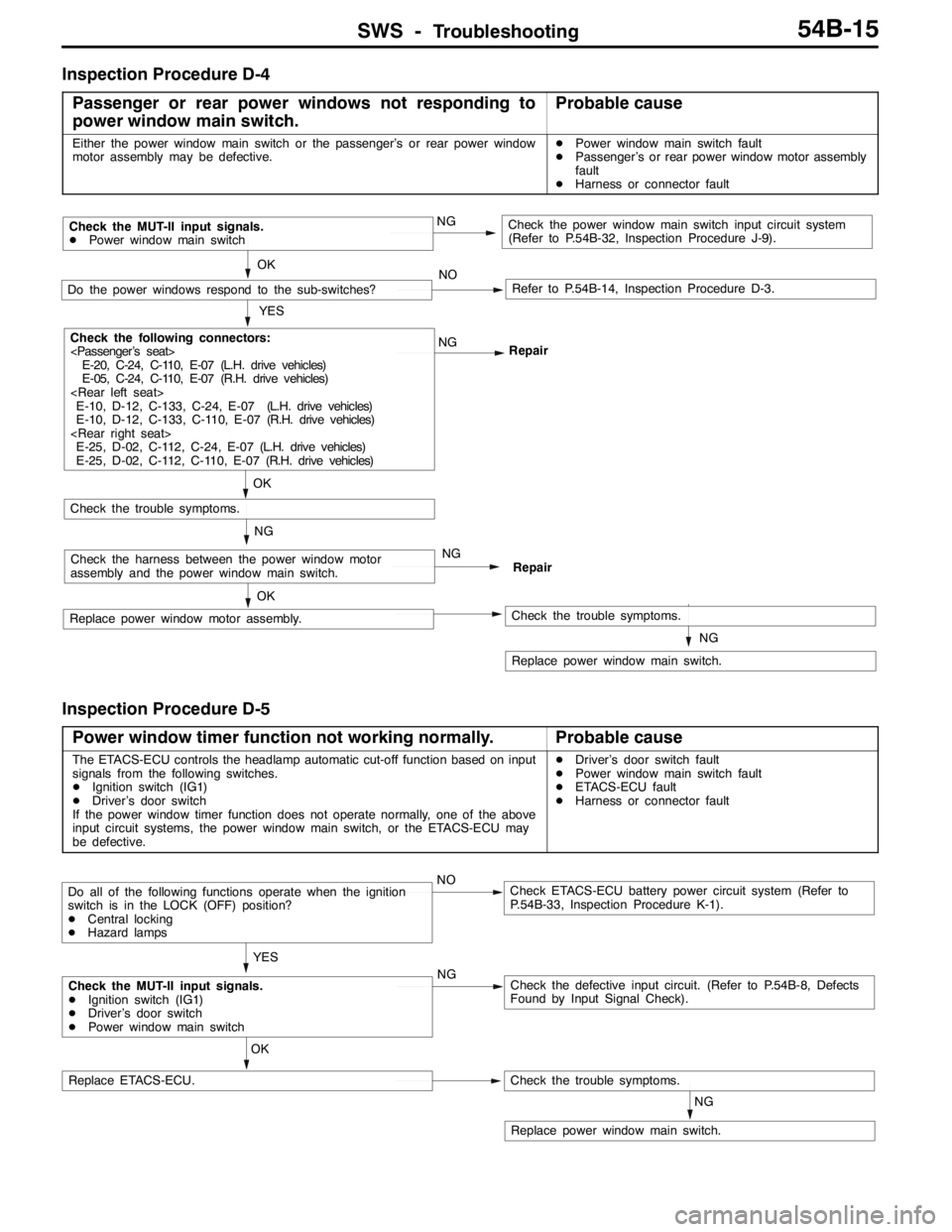
SWS -Troubleshooting54B-15
Inspection Procedure D-4
Passenger or rear power windows not responding to
power window main switch.
Probable cause
Either the power window main switch or the passenger’s or rear power window
motor assembly may be defective.DPower window main switch fault
DPassenger’s or rear power window motor assembly
fault
DHarness or connector fault
NG
Replace power window main switch.
OK
Replace power window motor assembly.Check the trouble symptoms.
NGCheck the harness between the power window motor
assembly and the power window main switch.NG
Repair
OK
Check the trouble symptoms.
YES
Check the following connectors:
E-20, C-24, C-110, E-07 (L.H. drive vehicles)
E-05, C-24, C-110, E-07 (R.H. drive vehicles)
E-10, D-12, C-133, C-24, E-07 (L.H. drive vehicles)
E-10, D-12, C-133, C-110, E-07 (R.H. drive vehicles)
E-25, D-02, C-112, C-24, E-07 (L.H. drive vehicles)
E-25, D-02, C-112, C-110, E-07 (R.H. drive vehicles)NG
Repair
OK
Do the power windows respond to the sub-switches?NORefer to P.54B-14, Inspection Procedure D-3.
Check the MUT-II input signals.
DPower window main switchNGCheck the power window main switch input circuit system
(Refer to P.54B-32, Inspection Procedure J-9).
Inspection Procedure D-5
Power window timer function not working normally.
Probable cause
The ETACS-ECU controls the headlamp automatic cut-off function based on input
signals from the following switches.
DIgnition switch (IG1)
DDriver’s door switch
If the power window timer function does not operate normally, one of the above
input circuit systems, the power window main switch, or the ETACS-ECU may
be defective.DDriver’s door switch fault
DPower window main switch fault
DETACS-ECU fault
DHarness or connector fault
NG
Replace power window main switch.
OK
Replace ETACS-ECU.Check the trouble symptoms.
Check the MUT-II input signals.
DIgnition switch (IG1)
DDriver’s door switch
DPower window main switchNGCheck the defective input circuit. (Refer to P.54B-8, Defects
Found by Input Signal Check).
Do all of the following functions operate when the ignition
switch is in the LOCK (OFF) position?
DCentral locking
DHazard lampsNOCheck ETACS-ECU battery power circuit system (Refer to
P.54B-33, Inspection Procedure K-1).
YES
Page 1384 of 1449
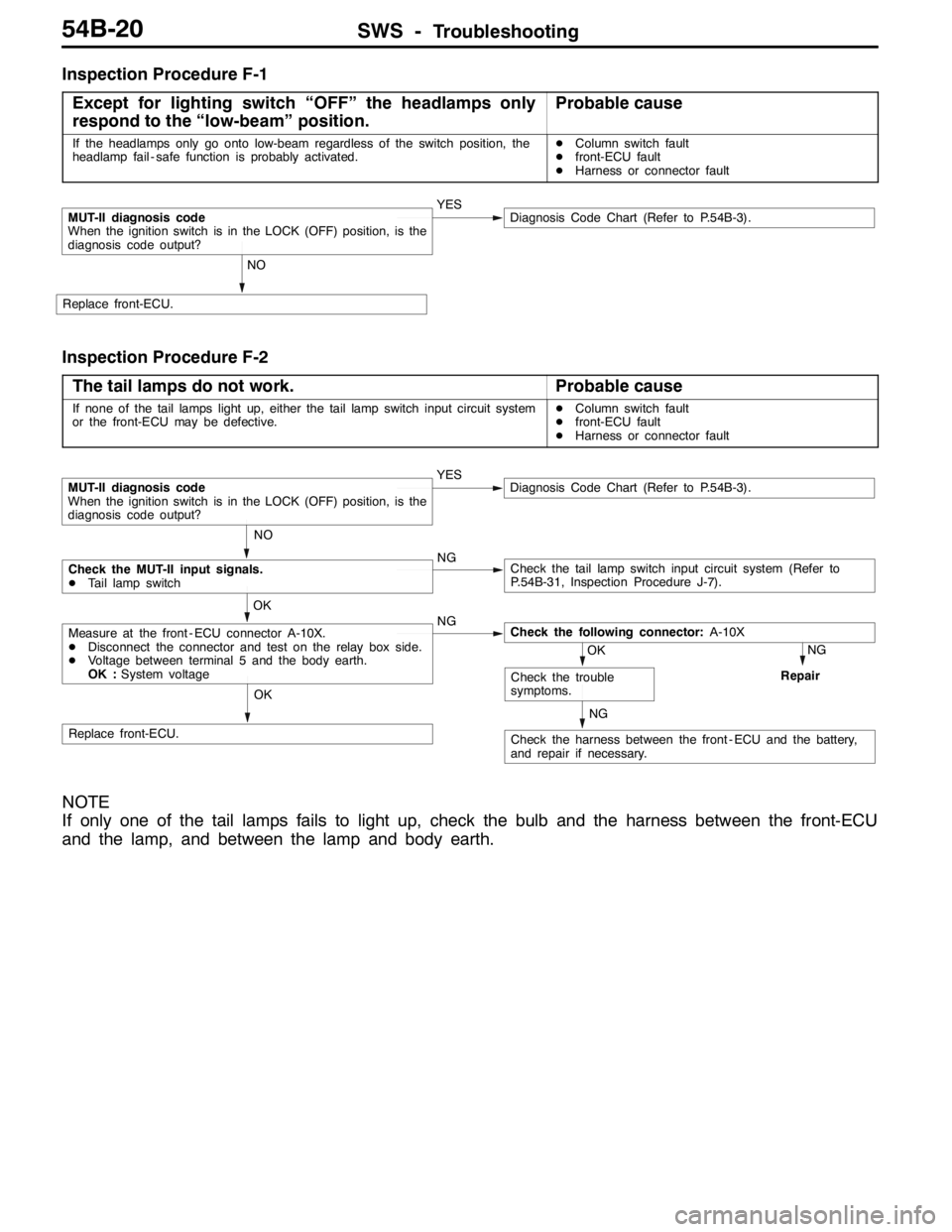
SWS -Troubleshooting54B-20
Inspection Procedure F-1
Except for lighting switch “OFF” the headlamps only
respond to the “low-beam” position.
Probable cause
If the headlamps only go onto low-beam regardless of the switch position, the
headlamp fail - safe function is probably activated.DColumn switch fault
Dfront-ECU fault
DHarness or connector fault
NO
Replace front-ECU.
MUT-II diagnosis code
When the ignition switch is in the LOCK (OFF) position, is the
diagnosis code output?YESDiagnosis Code Chart (Refer to P.54B-3).
Inspection Procedure F-2
The tail lamps do not work.
Probable cause
If none of the tail lamps light up, either the tail lamp switch input circuit system
or the front-ECU may be defective.DColumn switch fault
Dfront-ECU fault
DHarness or connector fault
NG
Repair
NG
Check the harness between the front - ECU and the battery,
and repair if necessary.
OK
Replace front-ECU.
OK
Check the trouble
symptoms.
OK
Measure at the front - ECU connector A-10X.
DDisconnect the connector and test on the relay box side.
DVoltage between terminal 5 and the body earth.
OK :System voltageNGCheck the following connector:A-10X
NO
Check the MUT-II input signals.
DTail lamp switchNGCheck the tail lamp switch input circuit system (Refer to
P.54B-31, Inspection Procedure J-7).
MUT-II diagnosis code
When the ignition switch is in the LOCK (OFF) position, is the
diagnosis code output?YESDiagnosis Code Chart (Refer to P.54B-3).
NOTE
If only one of the tail lamps fails to light up, check the bulb and the harness between the front-ECU
and the lamp, and between the lamp and body earth.
Page 1385 of 1449
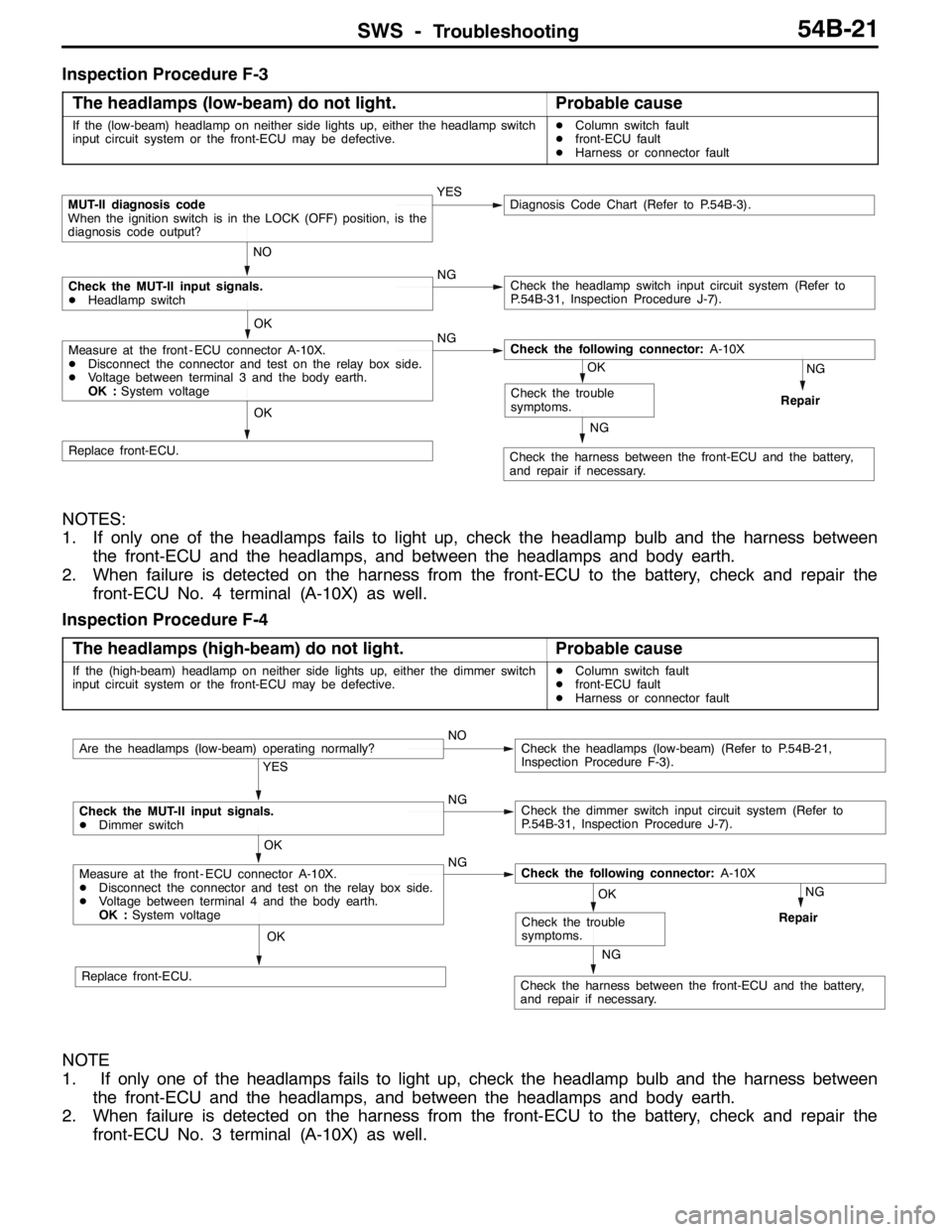
SWS -Troubleshooting54B-21
Inspection Procedure F-3
The headlamps (low-beam) do not light.
Probable cause
If the (low-beam) headlamp on neither side lights up, either the headlamp switch
input circuit system or the front-ECU may be defective.DColumn switch fault
Dfront-ECU fault
DHarness or connector fault
NO
Check the MUT-II input signals.
DHeadlamp switchNGCheck the headlamp switch input circuit system (Refer to
P.54B-31, Inspection Procedure J-7).
NG
Repair
NG
Check the harness between the front-ECU and the battery,
and repair if necessary.
OK
Replace front-ECU.
OK
Check the trouble
symptoms.
OK
Measure at the front - ECU connector A-10X.
DDisconnect the connector and test on the relay box side.
DVoltage between terminal 3 and the body earth.
OK :System voltageNGCheck the following connector:A-10X
MUT-II diagnosis code
When the ignition switch is in the LOCK (OFF) position, is the
diagnosis code output?YESDiagnosis Code Chart (Refer to P.54B-3).
NOTES:
1. If only one of the headlamps fails to light up, check the headlamp bulb and the harness between
the front-ECU and the headlamps, and between the headlamps and body earth.
2. When failure is detected on the harness from the front-ECU to the battery, check and repair the
front-ECU No. 4 terminal (A-10X) as well.
Inspection Procedure F-4
The headlamps (high-beam) do not light.
Probable cause
If the (high-beam) headlamp on neither side lights up, either the dimmer switch
input circuit system or the front-ECU may be defective.DColumn switch fault
Dfront-ECU fault
DHarness or connector fault
NG
Check the harness between the front-ECU and the battery,
and repair if necessary.OK
Check the trouble
symptoms.
NG
Repair
OK
Measure at the front - ECU connector A-10X.
DDisconnect the connector and test on the relay box side.
DVoltage between terminal 4 and the body earth.
OK :System voltageNGCheck the following connector:A-10X
YES
Check the MUT-II input signals.
DDimmer switchNGCheck the dimmer switch input circuit system (Refer to
P.54B-31, Inspection Procedure J-7).
OK
Replace front-ECU.
Are the headlamps (low-beam) operating normally?NOCheck the headlamps (low-beam) (Refer to P.54B-21,
Inspection Procedure F-3).
NOTE
1. If only one of the headlamps fails to light up, check the headlamp bulb and the harness between
the front-ECU and the headlamps, and between the headlamps and body earth.
2. When failure is detected on the harness from the front-ECU to the battery, check and repair the
front-ECU No. 3 terminal (A-10X) as well.
Page 1387 of 1449
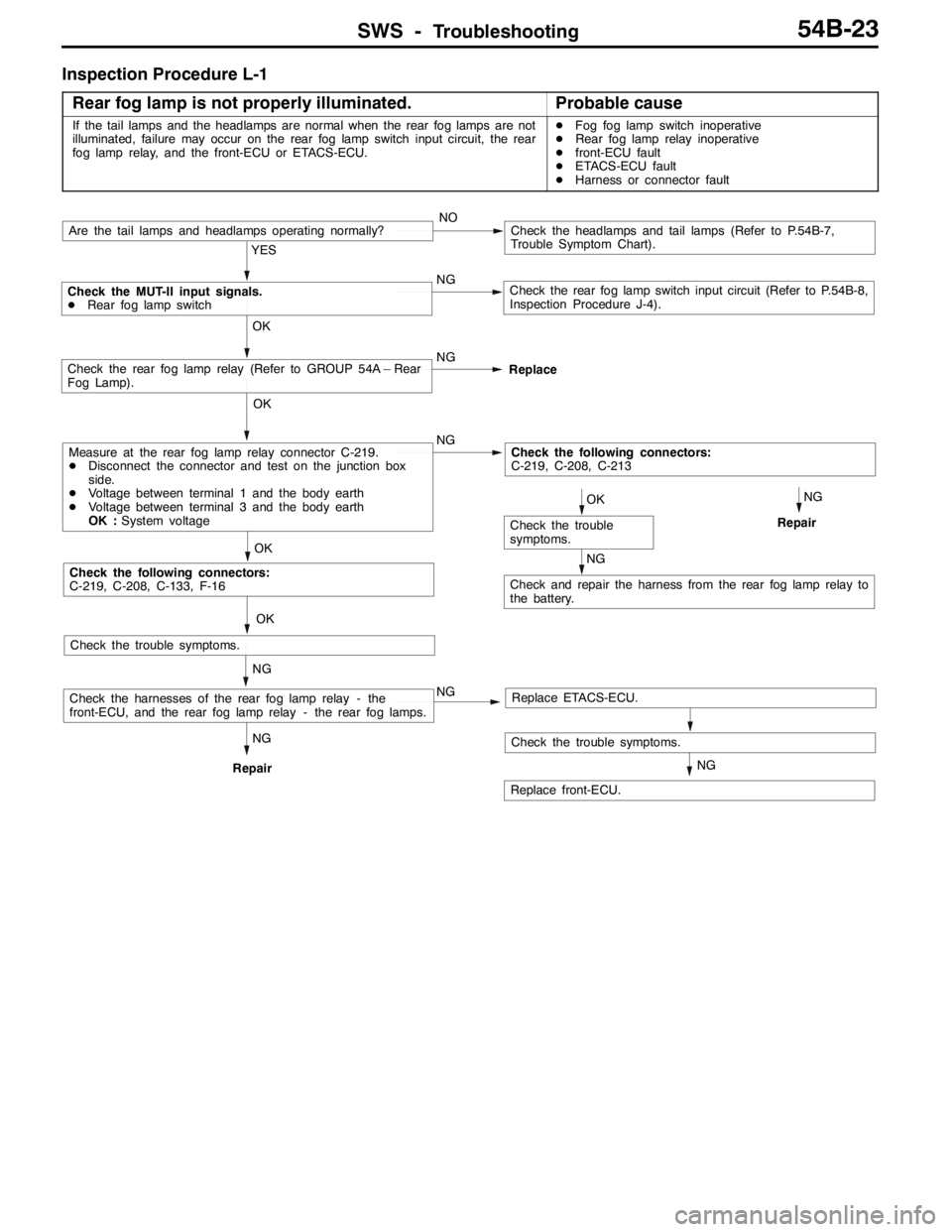
SWS -Troubleshooting54B-23
Inspection Procedure L-1
Rear fog lamp is not properly illuminated.
Probable cause
If the tail lamps and the headlamps are normal when the rear fog lamps are not
illuminated, failure may occur on the rear fog lamp switch input circuit, the rear
fog lamp relay, and the front-ECU or ETACS-ECU.DFog fog lamp switch inoperative
DRear fog lamp relay inoperative
Dfront-ECU fault
DETACS-ECU fault
DHarness or connector fault
Check the trouble symptoms.
NG
Repair
OK
Check the trouble symptoms.
YES
NG
Check the rear fog lamp switch input circuit (Refer to P.54B-8,
Inspection Procedure J-4).
Are the tail lamps and headlamps operating normally?NOCheck the headlamps and tail lamps (Refer to P.54B-7,
Trouble Symptom Chart).
OK
NG
Check the MUT-II input signals.
DRear fog lamp switch
Replace
OK
Check the rear fog lamp relay (Refer to GROUP 54A – Rear
Fog Lamp).
NGCheck the following connectors:
C-219, C-208, C-213
NG
Check and repair the harness from the rear fog lamp relay to
the battery.
OK
Check the trouble
symptoms.
Check the following connectors:
C-219, C-208, C-133, F-16
OK
Measure at the rear fog lamp relay connector C-219.
DDisconnect the connector and test on the junction box
side.
DVoltage between terminal 1 and the body earth
DVoltage between terminal 3 and the body earth
OK :System voltage
Replace ETACS-ECU.
NG
Replace front-ECU.
NG
RepairNG
NGCheck the harnesses of the rear fog lamp relay - the
front-ECU, and the rear fog lamp relay - the rear fog lamps.
Page 1388 of 1449
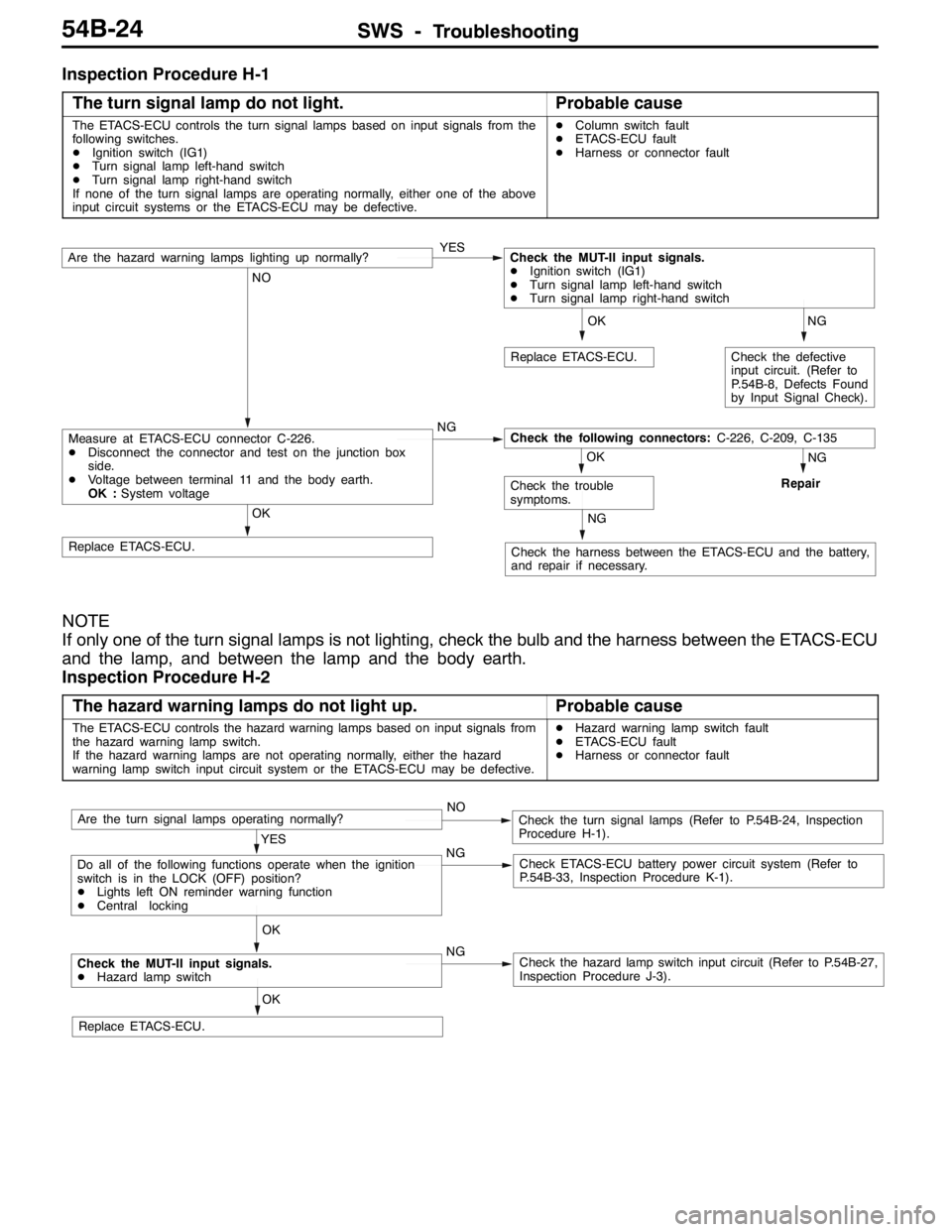
SWS -TroubleshootingSWS -Troubleshooting54B-24
Inspection Procedure H-1
The turn signal lamp do not light.
Probable cause
The ETACS-ECU controls the turn signal lamps based on input signals from the
following switches.
DIgnition switch (IG1)
DTurn signal lamp left-hand switch
DTurn signal lamp right-hand switch
If none of the turn signal lamps are operating normally, either one of the above
input circuit systems or the ETACS-ECU may be defective.DColumn switch fault
DETACS-ECU fault
DHarness or connector fault
NG
Check the defective
input circuit. (Refer to
P.54B-8, Defects Found
by Input Signal Check).
OK
Replace ETACS-ECU.
NG
Repair
NG
Check the harness between the ETACS-ECU and the battery,
and repair if necessary.Replace ETACS-ECU.
OK
OK
Check the trouble
symptoms.
NO
Measure at ETACS-ECU connector C-226.
DDisconnect the connector and test on the junction box
side.
DVoltage between terminal 11 and the body earth.
OK :System voltageNGCheck the following connectors:C-226, C-209, C-135
Are the hazard warning lamps lighting up normally?YESCheck the MUT-II input signals.
DIgnition switch (IG1)
DTurn signal lamp left-hand switch
DTurn signal lamp right-hand switch
NOTE
If only one of the turn signal lamps is not lighting, check the bulb and the harness between the ETACS-ECU
and the lamp, and between the lamp and the body earth.
Inspection Procedure H-2
The hazard warning lamps do not light up.
Probable cause
The ETACS-ECU controls the hazard warning lamps based on input signals from
the hazard warning lamp switch.
If the hazard warning lamps are not operating normally, either the hazard
warning lamp switch input circuit system or the ETACS-ECU may be defective.DHazard warning lamp switch fault
DETACS-ECU fault
DHarness or connector fault
OK
Replace ETACS-ECU.
OK
Check the MUT-II input signals.
DHazard lamp switchNGCheck the hazard lamp switch input circuit (Refer to P.54B-27,
Inspection Procedure J-3).
YES
Do all of the following functions operate when the ignition
switch is in the LOCK (OFF) position?
DLights left ON reminder warning function
DCentral lockingNGCheck ETACS-ECU battery power circuit system (Refer to
P.54B-33, Inspection Procedure K-1).
Are the turn signal lamps operating normally?NOCheck the turn signal lamps (Refer to P.54B-24, Inspection
Procedure H-1).
Page 1389 of 1449
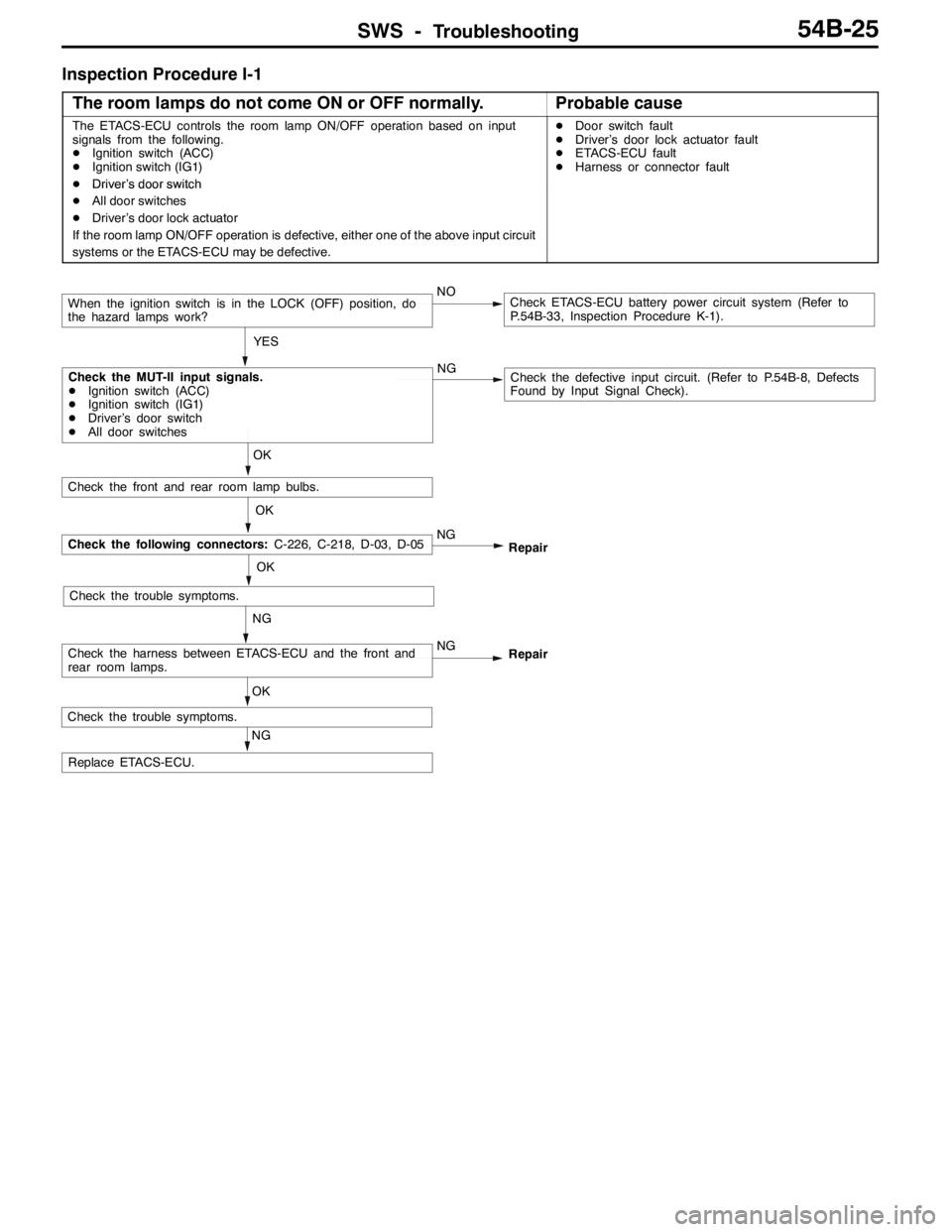
SWS -Troubleshooting54B-25
Inspection Procedure I-1
The room lamps do not come ON or OFF normally.
Probable cause
The ETACS-ECU controls the room lamp ON/OFF operation based on input
signals from the following.
DIgnition switch (ACC)
DIgnition switch (IG1)
DDriver’s door switchDDoor switch fault
DDriver’s door lock actuator fault
DETACS-ECU fault
DHarness or connector fault
DDriversdoorswitch
DAll door switches
DDriver’s door lock actuator
If the room lamp ON/OFF operation is defective, either one of the above input circuit
systems or the ETACS-ECU may be defective.
NGCheck the defective input circuit. (Refer to P.54B-8, Defects
Found by Input Signal Check).
OK
OK
NG
Check the trouble symptoms.
NG
RepairCheck the following connectors:C-226, C-218, D-03, D-05
NG
Repair
When the ignition switch is in the LOCK (OFF) position, do
the hazard lamps work?NOCheck ETACS-ECU battery power circuit system (Refer to
P.54B-33, Inspection Procedure K-1).
YES
Check the front and rear room lamp bulbs.
OK
Check the MUT-II input signals.
DIgnition switch (ACC)
DIgnition switch (IG1)
DDriver’s door switch
DAll door switches
NG
Replace ETACS-ECU.
OK
Check the trouble symptoms.
Check the harness between ETACS-ECU and the front and
rear room lamps.
Page 1397 of 1449
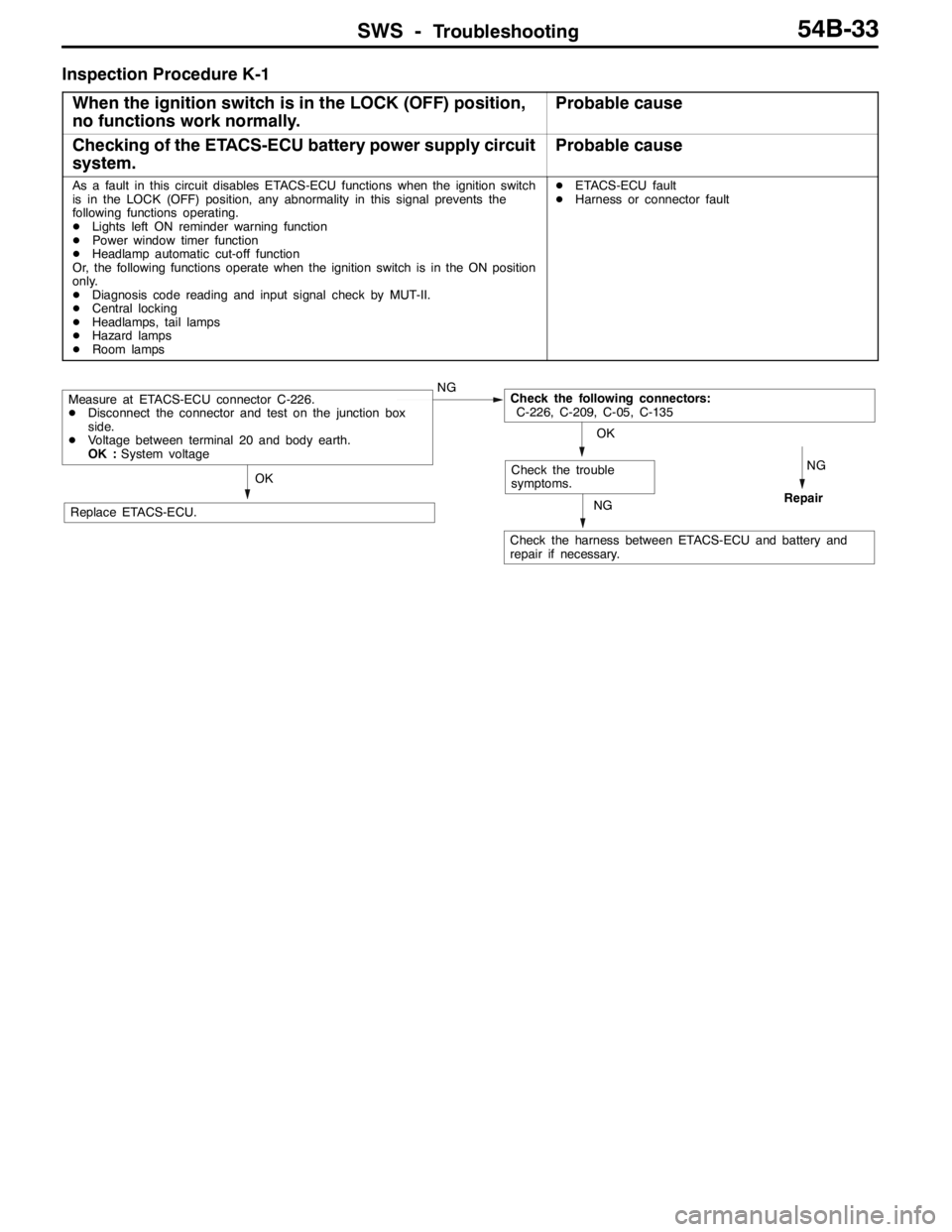
SWS -Troubleshooting54B-33
Inspection Procedure K-1
When the ignition switch is in the LOCK (OFF) position,
no functions work normally.
Probable cause
Checking of the ETACS-ECU battery power supply circuit
system.Probable cause
As a fault in this circuit disables ETACS-ECU functions when the ignition switch
is in the LOCK (OFF) position, any abnormality in this signal prevents the
following functions operating.
DLights left ON reminder warning function
DPower window timer function
DHeadlamp automatic cut-off function
Or, the following functions operate when the ignition switch is in the ON position
only.
DDiagnosis code reading and input signal check by MUT-II.
DCentral locking
DHeadlamps, tail lamps
DHazard lamps
DRoom lampsDETACS-ECU fault
DHarness or connector fault
NG
RepairNG
Check the harness between ETACS-ECU and battery and
repair if necessary.
OK
Replace ETACS-ECU.
OK
Check the trouble
symptoms.
Measure at ETACS-ECU connector C-226.
DDisconnect the connector and test on the junction box
side.
DVoltage between terminal 20 and body earth.
OK :System voltageNGCheck the following connectors:
C-226, C-209, C-05, C-135